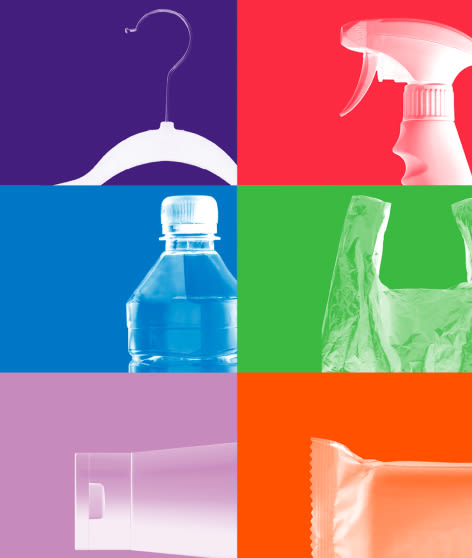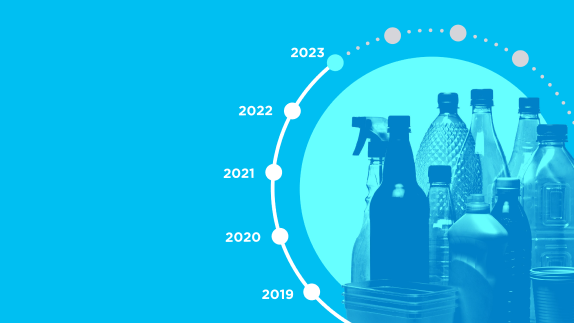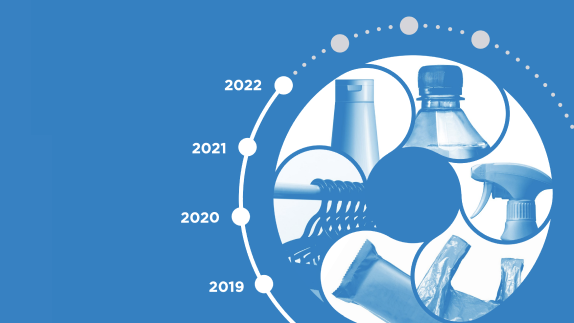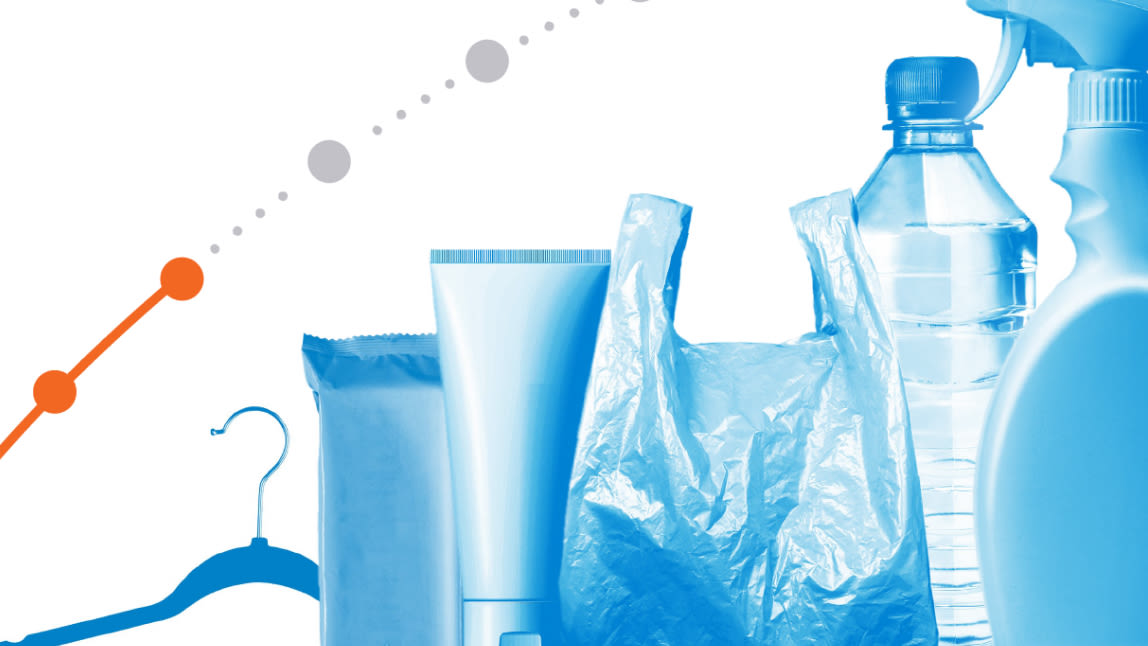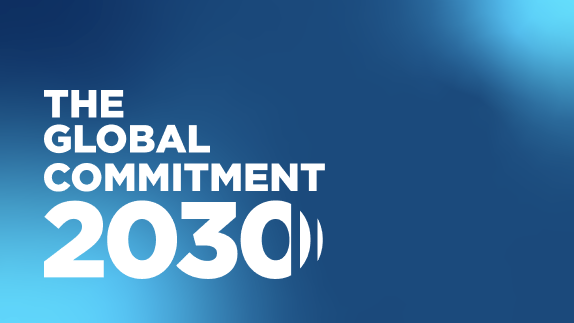Published as part of the Global Commitment Progress Report 2022 by the Ellen MacArthur Foundation and UN Environment Programme
Overall trends
Most retail signatories (64%) increased their virgin plastic packaging between 2020 and 2021, resulting in a 6.8% increase for the sector. This was largely driven by a growth in total plastic packaging (+8% on average) which outpaced the increase in post-consumer recycled (PCR) content. This increase is plastic packaging is notably attributed to the rebound effect of the COVID-19 pandemic for signatories with food services and an increase in sales. Overall, between 2018 and 2021, virgin plastic packaging increased by 11% on average for the sector.
While retail signatories are implementing a higher number of reuse pilots and models, focused on refill-on-the-go and return-from-home, these pilots did not necessarily translate to an increase in the share of reusable plastic packaging. Retailers reported the expansion of their refill stations to offer more products, especially dry foods, beverages, and household and personal care products, and additional locations. However, most sector signatories (73%) did not increase their share of reusable plastic packaging.
Actions to accelerate progress
Retailers should use their key role to significantly scale reuse solutions. Brands and retailers are strongly encouraged to collaborate to overcome existing barriers faced by reusereuseThe repeated use of a product or component for its intended purpose without significant modification. models in the sector. Reuse solutions can be made more attractive to consumers by sharingsharingThe use of a product by multiple users. It is a practice that retains the highest value of a product by extending its use period. refill stations with direct competitors and standardising packaging across products. Customer convenience can be improved by leveraging digital solutions such as the Internet of Things (IoT) to apply them across dispensing units and e-commerce platforms to facilitate integrated use and purchase of refills.
Addressing the growing use of plastic packaging and especially non-recyclable plastic packaging should remain a key priority. Given the strong increase in plastic packaging weight – which will pose challenges for retailers to achieve their virgin or total reduction target – signatories should reduce their total plastic packaging use along with accelerating use of PCR content. The priority focus should be non-recyclable plastic packaging, which represents an important share of signatories’ portfolios (57% on average). This mostly includes flexible plastic packaging (representing 44% of signatories’ portfolios), as well as PP pots, tubs, and trays (13%), and PET thermoforms (6%). Companies will need to innovate away from such packaging through elimination or reuse, or invest in the recycling infrastructure where a credible recycling pathway exists.
Reduction targets
Average change in virgin plastic packaging from 2020 to 2021: +6.8%
In 2021, signatories have set 2025 targets to reduce their virgin plastic packaging (i) or total plastic packaging (ii) as part of the mandatory requirements to remain in the Global Commitment.
Trends
In 2021, ten out of the eleven signatories set a virgin reduction target, by 16% on average, and three set targets to reduce the total amount of their plastic packaging.
Between 2020 and 2021, the sector reported an increase in virgin plastic of 6.8%, driven by the majority (64%) of the signatories for which plastic packaging growth outpaced the increase in PCR content. The remaining signatories decreased virgin plastic packaging use mostly through increasing PCR content.
Looking at the overall trend from 2018 to 2021, the sector increased its virgin plastic packaging by an average of 11%.
i. Virgin reduction targets aim to decrease the total weight of virgin plastic in packaging, and should be underpinned by efforts on reuse and elimination in addition to increasing the use of recycled content.
ii. Total reduction targets aim to reduce the total weight of plastic packaging.
For more information about the reduction targets read the 2022 Progress Report.
Elimination of problematic or unnecessary plastic packaging
Trends
Retail signatories continue to target materials that are hard to recyclerecycleTransform a product or component into its basic materials or substances and reprocessing them into new materials., such as PVC, undetectable carbon black, PS, EPS, and multilayer plastic packaging, with more than 40% of signatories with these packaging types in their portfolio eliminating or reducing them.
Six signatories (40%) reported the direct elimination of packaging or components, such as multibuy packs, lids for yoghurt, single-use carrier bags, straws or cutleries as well as shrink wraps. However, only a few signatories reported going beyond these packaging types or moving away from material substitution (to another plastic or paper) to remove the need for single-use packaging in the first place.
Highlights
Ahold Delhaize eliminated dairy pot lids and plastic packaging used in multipack concentrated tomato cans in some Delhaize stores, discontinued plastic bags for fruits and vegetables in its Albert Heijn stores, and is introducing dry misting technology for fruits and vegetables in Romania.
Starbucks Coffee Company announced that it will replace single-use cups with reusable alternatives in stores across South Korea by 2025.
Along with having eliminated 97% of EPS and 30% in 2021, Kmart Australia aims to fully eliminate EPS, multilayer material, PETG in rigid plastic packaging, PVC, and undetectable carbon black by 2025.
Moving from single-use towards reuse models
Reusable plastic packaging in 2021: 3.8% (▼1.4pp vs 2020)
Trends
Retail signatories launched 48 reuse pilots in 2021, with five reporting more than three reuse pilots. Refill-on-the-go is the most popular model, with 60% of signatories implementing or expanding refill stations for household and personal products, drinks, and dry foods. Some signatories are also reporting on measures to make reusable offerings more attractive (e.g. by offering discounts), and are monitoring the refill rates of their packaging.
However, the majority (73%) of signatories did not report any increase in their percentage of reusable plastic packaging. Four signatories increased this share, notably by introducing more refillable bottles for refill stations and using reusable B2B boxes.
Highlights
Starbucks Coffee Company will launch a reusable cup-sharing programme in its stores, including incentivising reusables and disincentivising single-use (e.g. discounts and surcharges), and is trialling cup-washing stations in select US locations.
Adhering to regulations in France, Carrefour will ensure 5% of its packaging is reusable by 2023 (10% by 2027), and has rolled out a recovery system to enable beer bottle reuse.
Finnish S Group is in discussion with different industries and authorities to create a national commitment to move towards reuse models for food takeaways, replacing single-use packaging.
Ahold Delhaize will provide refill options for 70 food products across stores in the US and the Netherlands.
100% of plastics packaging reusable, recyclable, or compostable (RRC)
RRC in 2021: 43% (▲1.5pp vs 2020) || 2025 target: 100%
Trends
The average proportion of reusable, recyclable, or compostable plastic packaging increased marginally driven by an increase in recyclabilityrecyclabilityThe ease with which a material can be recycled in practice and at scale..
Signatories reported collaborating with regulators, industry companies, and innovators to better collect and sort plastic packaging, and improve the design of their packaging for recycling by eliminating PVC, PS, and undetectable carbon black. However, on average 57% of signatories’ packaging remains non-recyclable. This includes PP pots, tubs, and trays, PET thermoforms, and consumer-facing flexible packaging such as carrier bags and shrink wraps – these will need addressing through elimination or scaling recycling infrastructure.
Highlights
Schwarz Group is working with regulatory actors and other value chain partners to implement deposit schemes for the collection of plastic bottles in several countries. Additionally, the company – along with others such as Carrefour – are participating in the national testing phase for the Holy Grail 2.0 project to use digital watermarking for improved sorting of plastic packaging waste.
In 2021, Ahold Delhaize began a collaboration with plastic recycling company Umincorp and packaging producer Hordijk to recycle old PET containers into new ones (i.e. tray-to-tray recycling), to ensure more plastic is available to recycle into bottles.
Post-consumer recycled content (PCR) targets
PCR in 2021: 14% (▲2.0 pp vs 2020) || 2025 target: 27%
Trends
Ten signatories (77%) increased their PCR content, particularly by incorporating recycled content in PET bottle packaging, with three signatories (23%) increasing their PCR content by 4 or more percentage points.
Many retail signatories reported working closely with suppliers to secure recycled content to meet rising demand for recycled plastics amid global shortages.
Highlights
SONAE MC, which has one of the highest proportions of PCR content in the group (22%) reported setting minimum requirement levels for recycled content in new packaging and publishing guidelines to support suppliers towards reaching their 2025 targets.
Schwarz Group increased its PCR content by 3.6pp to 14% by introducing up to 100% recycled PET in cleaning products, and food and beverage packaging.
To address global shortages, Walmart is piloting reverse collection projects such as the El Paso thermoform recycling pilot and Walmart Community Recycling Hubs, in addition to working with suppliers to secure additional supplies of PCR content.
Retail sector compared to other sectors
Endnotes
General note: Some quantitative metrics for 2020 might differ from those reported in the sector insights published in 2021 as some companies updated prior years’ metrics due to improvement in methodology, merger and acquisition or scope expansion.
The change in virgin plastic packaging represents the non-weighted change reported by all signatories in the sector.
For signatories where data on key metrics was lacking for 2018 on virgin plastic packaging, data was extrapolated based on the metrics’ average for the group.
EPS = Expanded Polystyrene; PS = Polystyrene; PVC = Polyvinyl chloride
In this document, the quantitative metrics for 2021 and 2025 targets represent the non-weighted average of the data reported by all signatories in the sector. The year-on-year changes reported across all metrics refer to those seen for signatories reporting in both of the last two years (i.e. data from signatories reporting for the first time in 2022 are not included as part of the change).
To be claimed as recyclable/compostable according to the Global Commitment definition of recyclable/compostable ‘in practice and at scale’, packaging needs to meet the thresholds of being recycled/composted at a 30% rate across multiple regions, collectively representing at least 400 million inhabitants. For more information, see ‘How are recyclability and compostability assessed in the Global Commitment?’ in the 2022 Progress Report.
In this document, the quantitative metrics for 2020 and 2025 targets represent the non-weighted average of the data reported by all signatories in the sector. The year-on-year changes reported across all metrics refer to those seen for signatories reporting in both of the last two years (i.e. data from signatories reporting for the first time in 2021 are not included as part of the change).
Ibid.
EPS = Expanded Polystyrene; HDPE = High-density polyethylene; PE = Polyethylene; PET = Polyethylene terephthalate; PP = Polypropylene; PS = Polystyrene.
The 2025 target reported is for sector signatories with virgin plastic packaging reduction target, and as such excludes signatories with a total reduction target.
Disclaimer
This report has been produced by the Ellen MacArthur Foundation (the “Foundation”). The Foundation has exercised care and diligence in preparing this report, based on information it believes to be reliable, but makes no representations and gives no warranties, assurances or undertakings (express or implied) in connection with it or any of its content (as to its accuracy, completeness, quality, fitness for any purpose, compliance with law, or otherwise).
The Foundation does not monitor or moderate any external websites or resources linked or referred to in this report. This report does not purport to be comprehensive and none of its contents shall be construed as advice of any kind. Any reliance on it is at reader’s own discretion and risk.
All information on signatories’ progress in these sector insights has been provided by the relevant signatories and has not been audited or verified by the Foundation or UN Environment Programme (UNEP). Each signatory is responsible for the information it submitted.
The Foundation and UNEP do not warrant that all information submitted by individual signatories is contained or represented in this report and, without limiting the generality of the foregoing, the Foundation may: (i) have excluded data which it believes to be inaccurate; (ii) have excluded from year-on-year calculations data from signatories which have not reported data in both years; and (iii) have normalised information to produce the aggregated and averaged statistics featured in this report. Further, if a signatory has not reported by the relevant deadline(s), its data will not be included in this report. If you are a signatory and you believe there has been an error in the reproduction of the information provided to us by your organisation, please contact us as soon as possible at reportingGC@ellenmacarthurfoundation.org, or your contact at UNEP.
To the maximum extent permitted by any applicable law, the Foundation, each entity within its group and each of its associated charities and their respective employees, workers, officers, agents and representatives disclaim in full all liability for any loss or damage of any kind (whether direct or indirect and whether under contract, tort, breach of statutory duty or otherwise) arising under or in connection with this report or any of its contents.
Contributions to this report by any third party do not indicate any partnership or agency relationship between that contributor and the Foundation, nor the endorsement by the Foundation of that contributor or the endorsement by that contributor of this report’s conclusions and recommendations.
The Foundation is not a supplier of, or otherwise affiliated with, and does not recommend or endorse, any third party or the products or services referred to in this report.
About these sector insights
This document presents insights and data on the progress made by retail signatories listed below to achieve their commitments on plastic packaging. This document is part of the 2022 Global Commitment Progress Report.
About the Global Commitment
The Global Commitment is an initiative led by the Ellen MacArthur Foundation, in collaboration with the UN Environment Programme. Through the Global Commitment, businesses and governments commit to change how we produce, use, and reuse plastic. They will work to eliminate the plastic items we don’t need; innovate so all plastic we do need is designed to be safely reused, recycled, or composted; and circulate everything we use to keep it in the economy and out of the environment. Learn more
Global Commitment signatories reporting in this sector
A.S. Watson Group
Ahold Delhaize
Carrefour
El Corte Inglés, S.A.*
Jerónimo Martins
Kesko Corporation
Kmart Australia Limited
Pick n Pay
S Group
Schwarz Group (Lidl & Kaufland)
Selfridges
SONAE MC
Starbucks Coffee Company
Target Corporation
Walmart Inc.
Woolworths Holdings Limited*
*These signatories did not provide data for one or more metrics for 2020 and so are excluded from year-on-year comparisons for the relevant metric(s).



